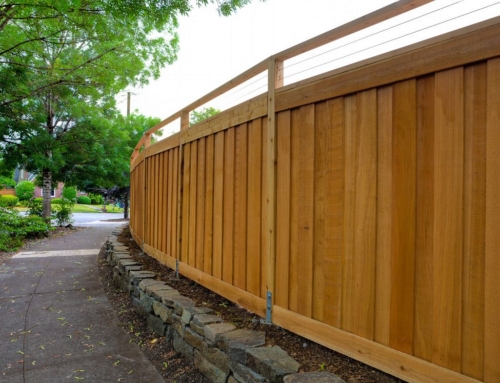Aluminum vs Wood Picket Fence Honest Comparison
Aluminum vs Wood Fence an Honest Comparison
We have customers ask us all the time, which is better? Aluminum or Wood Picket Fencing? Both are great fence choices and have very different qualities to consider. Some of our customers like the natural wood picket fence for the cracks, wood grain, and knots in the lumber. This adds “character” to the fence and is a desirable quality. They enjoy taking care of their fence, cleaning staining, and repairing the fence. Many of our customers are not so inclined to do any maintenance! I guess I fall into that category. Once the product is up, I do not want to have to touch it again! So now let’s look at these two fine fence choices and see what best fits your specific needs and objectives.
Aluminum vs Wood Picket Fence: Visuals
Here is where your personal choice is all that matters! Many of our customers love the old rugged weathered wood picket fence look! The more flaws the better to add distinction and personality to the fence. The wood picket fence is usually built with 3″ or 4″ wide pickets spaced 2″ – 3″ apart. This creates a barrier, is great to hide utility meters, and is great for landscaping accents.
Aluminum fencing is styled after the expensive and high maintenance wrought iron fencing. Aluminum pickets are normally 5/8″ wide (very narrow) and spacing is close to 4″ between pickets. Optional tighter picket spacing is always available, I am using the most common styles for comparison. The aluminum picket fencing has an open airy feel about it, so this is not a good fence for concealing the yard. It is, however, a great pool fence since you can see if someone gets in trouble. With the aluminum fence, you do not have the “character flaws” of a wood fence: No splinters, no warping, and no painting.
Aluminum vs Wood Picket Fence: Maintenance
For me, this is a huge issue! When I was in my 20s, I loved doing all kinds of maintenance around the house. Staining the fence was no big deal, replacing boards or a warped post…no big deal. Now that I’m in my 50s, I raise an eyebrow at anything needing maintenance. I guess I feel like I’ve paid my dues. Let the young kids do all that work. So for me, maintenance is a huge issue, and definitely a deal-breaker!
Aluminum fencing, on the other hand, requires no maintenance…period! (I like this one already!) The most popular residential color is black with over 90% of our sales. Bronze comes in second, but black is the clear winner. We keep the 4′ black English Traditional aluminum fence and American Classic aluminum fence in current inventory for a quick installation turnaround.
Aluminum vs Wood Picket Fence: Budget Costs
Both of these fence types aluminum fencing and wood picket fencing have different costs associated with them. I find that many customers may rush into an initial decision based on cost without looking at the overall picture. Sure, some customers will specify a certain fence is what they want, but let’s take a look at the true cost of each fence and place that value somewhere in the purchasing decision.
Aluminum fencing will have an initial installed cost and over ten years, there are no more maintenance costs. Of course, accidents such as a car running into the fence can happen, but that is not what we are talking about here. The natural wood picket fence will offer a lower initial installed cost, but remember to add into this cost the costs of 1st year of staining the fence (both sides, two coats first time). By adding this additional cost to the wood picket fence, this fence cost compared to aluminum is approaching only a 15% to 20% difference.
Aluminum vs Wood Picket Fence: Residual Value
Now that you have considered the style and purpose of your fence, the initial costs of your fence, and the maintenance aspects of your fence, let’s look at the residual value of the fence. Yes, RESIDUAL VALUE! That is the added dollars to the price of your house when ready to sell in 10 years. I don’t know about you, but when I buy a truck, I want to know what the estimated resale value will be in 4 years. If I’m looking at two similar trucks, the one that holds the best value is going to be my pick.
Residual value is seldom considered on the front end when purchasing a fence. The true cost of your fence is the initial cost plus the improvements (maintenance and staining) and subtract the final value when selling the house. The true cost of a wood picket fence will be the initial cost plus all the staining for 10 years less the 10% residual value. Compare that cost to the cost of an aluminum fence with the same parameters, initial costs plus maintenance ( zero maintenance costs for 10 years) less an impressive 65% residual value.
As you can see on the chart above, aluminum fencing’s initial cost is $4950, and zero additional maintenance costs. A residual value of 65% (aluminum fence has excellent residual value) of the initial cost is $3,217.50. Subtracting out the resale from the original you end up with a TRUE COST of ONLY $1,732.50 for 10 years of aluminum fencing!
Natural Wood Fencing with an initial cost of $3,600 plus first-year staining brings it up to $750 to $4,350. Adding the maintenance for the next 9 years adds another $2,800 in additional costs over the original investment, for a total of $7,150. Now let’s take the residual value (30% may be high) of only the original $3,600 cost for a value of $1080. Total costs for a well-maintained wood picket fence are over $6,000! OK, let’s say you are not so industrious, and let’s cut the staining and maintenance costs in half. Now we have the original cost of $3,600 plus 1/2 maintenance costs of $1,775 for a total of $5,375 (more than the cost of the aluminum fence), subtracting out the $1,080 residual costs leaving $4,295 or $429.50 a year cost! (Aluminum at $173.50 is still a better deal!) You spend a lot of money for maintenance on the wood and you also get to enjoy that beautiful wood fence for all of those years, sometimes the tradeoff is worth it.
OK, OK, let’s just say that you purchase a wood picket fence and for 10 years you do absolutely no maintenance, no staining, nothing at all to it. So the initial cost is $3,600 and for the next 10 years, you have a gray ragged fence next to your beautiful home. First impressions and curb appeal sell homes, if your fence is not up to par, it WILL pull your home value down! Alright, let’s take the cost of the original fence $3600, and subtract the residual value if any, say $360 (very little residual value for an old wood fence) for a total 10-year cost of $3240. That is $3240 for an old ragged wood fence, almost double the total cost of the aluminum fence at $1732.50.
OOPS, I forgot that in this example we are selling the house! So even though you never spent any money on maintenance, you will need to now to try not to hurt your home value. You could spend $750 to stain and make repairs, or about the same to have a company pull and haul off. Either way, if you add the $750 to clean up your fence to sell the house added to the cost of the fence at $3,240 you are looking at a $3990 total cost for that old fence you had to look at these last 10 years!
So there it is, from a cost perspective, a maintenance perspective, and atheistic perspective aluminum is the winner. Some homeowners will enjoy the wood fencing and character it brings to their home, knowing it will cost more, and they are ok with that.









